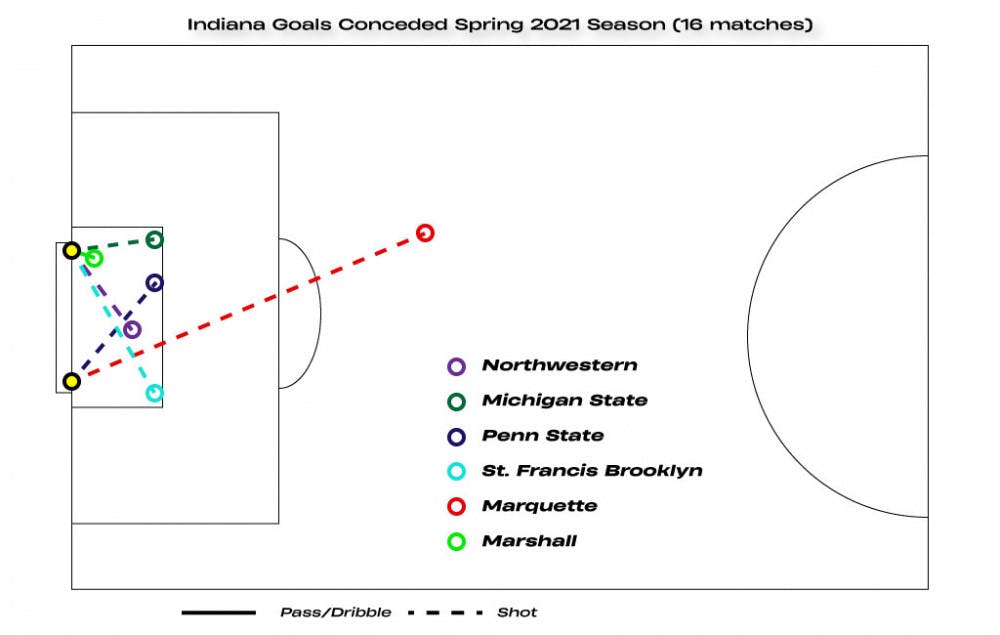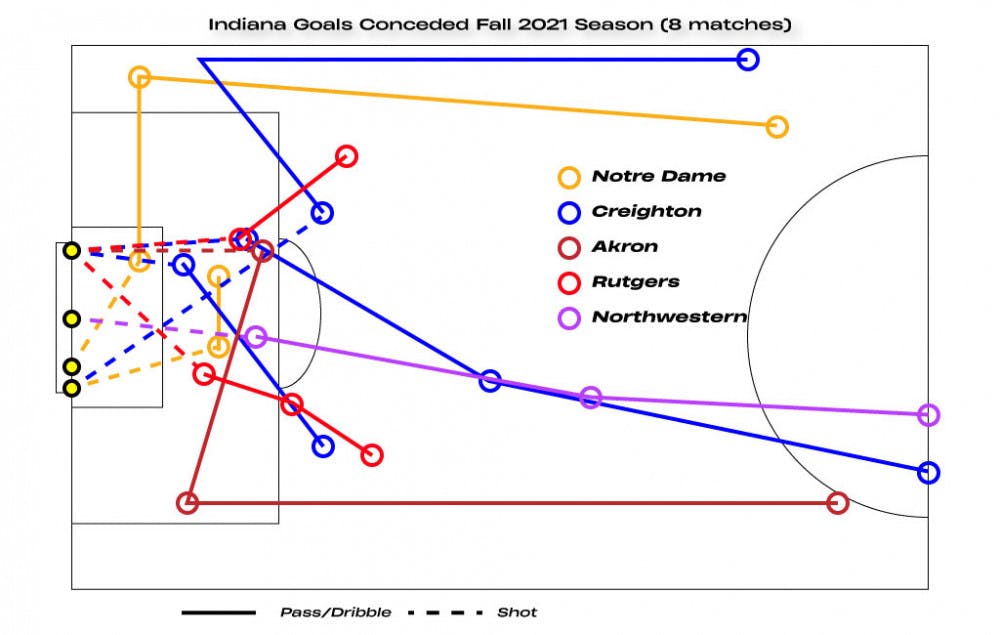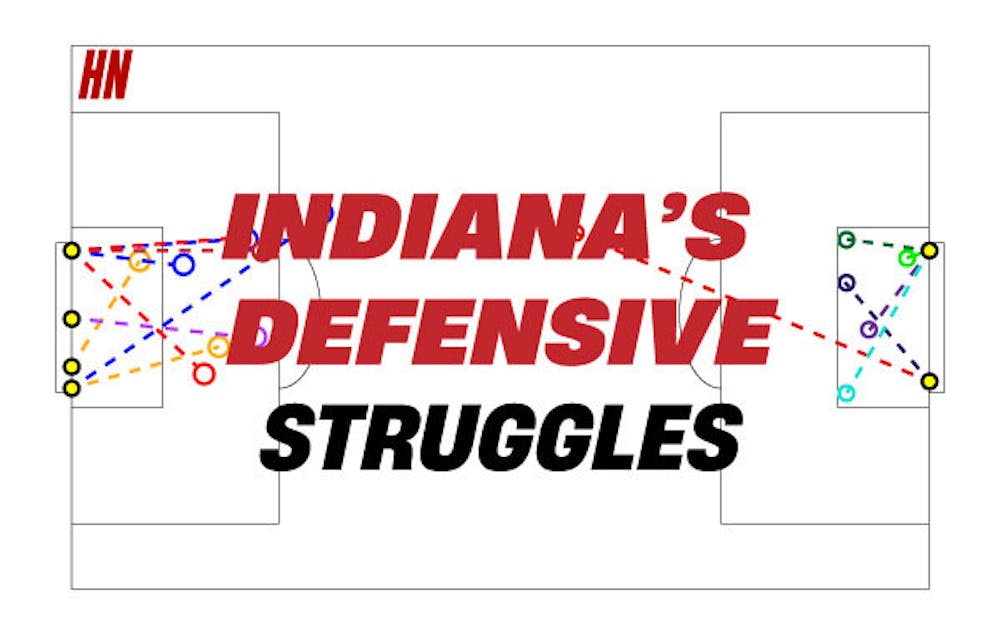In the spring 2021 season, IU men’s soccer showcased one of the best defenses in recent collegiate memory. Across 16 games -- the most played of any team in the nation -- the Hoosiers allowed just six goals, tallied 10 shutouts and never conceded more than one goal in a single match.
Fast forward just a few months later, and through eight matches this fall, Indiana’s defense has looked more vulnerable than they did at any point in the spring.
What’s gone wrong? It certainly isn’t the personnel as every member of last season’s defense returned, including two All-Americans in goalkeeper Roman Celentano and left back Spencer Glass.
Despite the extensive experience and talent along IU’s backline, it’s already conceded nine goals in eight matches -- three more than all of last season in eight fewer games -- and two or more goals in three matches. Even more concerning, unranked Creighton blitzed IU for three goals in a match that was heavily one-sided from the opening touch.
Is complacency the issue? Has IU’s strategy finally been countered? Let’s dive into what happened last year, how it can provide a blueprint for the current issues, and potential solutions to fix the backline woes.
A LOOK BACK AT THE SPRING
Indiana’s resoluteness on defense and goal-keeping heroics from Celentano saw the Hoosiers embark on a trip to the National Championship, where they lost to Marshall, 1-0, in overtime. When reflecting on Marshall’s game-winning goal, Celentano described it as a brief loss of focus. It appears Indiana hasn’t regained that since.
However, throughout the NCAA tournament and the Big Ten season leading up to the College Cup, Indiana attacked and defended as a unit, and displayed great focus and decision-making to pull out narrow victories.
Let’s take a look at the six goals Indiana conceded last season:

Five goals conceded in the box and one super strike from range completes the six goals IU allowed. So, what does that mean?
To me, it indicates a stubbornness to allow teams good looks inside the 18-yard box. All three goals conceded in Big Ten action (to Northwestern, Michigan State and Penn State, respectively) came from restarts.
Northwestern scored off a flicked header off a long throw.
Michigan State scored off a corner kick directly.
Penn State scored after a nice move following a rebound off a corner kick.
Up until a 90-yard pass against St. Francis Brooklyn and a wonder goal from Marquette in the Sweet Sixteen, Indiana hadn’t conceded a single goal from open play. Those you can chalk up as a nice move from the opponent with some luck involved.
The sixth and final goal was a rebound in the National Championship.
Over 16 matches, Indiana was confined to just six scrappy (and occasionally brilliant) moments from their opponents. The Hoosiers offered foes nearly nothing in terms of mistakes and refused to concede well-worked goals.

The location of those goals showcase a team that couldn’t be broken down from deep lying positions: a true testament to the dedication of Indiana’s midfield and forward line in supporting the defense.
Should we hold Indiana to such high standards again this season? Yes, I think so.
Though Indiana lost two key pieces in the offseason -- midfielder A.J. Palazzolo and forward Thomas Warr -- it gained three exciting freshmen in midfielders Patrick McDonald and Tommy Mihalic and forward Sam Sarver.
But even with those additions and the plethora of returning contributors, Indiana seemingly didn’t return the same defensive unit.
PROBLEMS IN THE FALL
Indiana entered this season ranked No. 2 in the country, and with it came another round of immense expectations in pursuit of the coveted ninth star.
While six goals conceded in a pair of exhibition matches to Louisville and Wright State could be chalked up as rust, it marked the start of something more concerning.

At face value, nine goals is three more than were conceded all of last season, and in half the amount of matches.
Let’s narrow it down to just the goal-scoring shots that IU has conceded.

One from range, one inside the six-yard box and seven within eight to 18 yards of the net.
This shows the most clear regression for Indiana -- where last season there was almost always an IU midfielder or forward closing down a late run or an attempted shot from an opposing midfielder or defender. This season, however, opponents have far more space to operate and create dangerous chances.
Generally, when center back’s Joey Maher and Daniel Munie move closer to the goal on defense, a chasm opens between them and a nearby midfielder.
Palazzolo excelled last season in winning the ball back in the midfield and killing opportunities before they developed. But Palazzolo is no longer a Hoosier.
Does this mean Indiana’s midfield is the problem? Not really.
McDonald and Joe Schmidt have held down the midfield as part of a 4-4-2 alignment that regularly becomes a 4-2-4 with players like Mihalic, Herbert Endeley, Maouloune Goumballe and Ryan Wittenbrink all bringing significant attacking ability.
They have done a good job in chance creation, ball progression and retention, and rarely are the victim of mistakes. But overall, Indiana’s defensive shape has regressed. It’s not down to an individual, it’s down to a group.
It’s also no disrespect to the freshman McDonald to suggest that the senior Palazzolo was more vocal and a better leader. That’s just simple age and experience, something McDonald will develop over time. Warr exchanged for a combination of Mihalic and Sarver is a similar removal of veteran savvy and leadership, but also increased talent and spark.
The consequence is a team that needs to sort itself out over time. Starting three freshmen like Indiana did at the start of the campaign is rare, but an indication of trust from the coaching staff. As a result of the youth movement, the Hoosiers’ shape and cohesiveness has taken a hit.
When comparing the raw shot numbers over the first eight matches this season and last season, the struggles become increasingly glaring.
Last season: 63 shots faced, an average of just under 10 shots per match.
This season: 94 shots faced, an average of just under 12 shots a match.
So how does IU fix this?
THE SOLUTION TO INDIANA'S DEFENSIVE PROBLEMS
Now, what would I, a man who’s organized soccer experience peaks at recreational soccer in high school, do to fix a team with aspirations for a National Championship?
Trust Todd Yeagley, mostly.
Indiana clearly has the talent, but it needs to improve its defensive shape and concentration in key moments. That will almost certainly come as the season progresses.
However, it’s still a lingering problem in its current form, and it needs to be solved quickly. For the Hoosiers to set the groundwork for another College Cup run this winter, it must start with discipline and desire from top to bottom.
We’ve seen Yeagley phase McDonald and Sarver out of the starting lineup in place of more experienced players in the last two matches, both in place of Quinten Helmer and Wittenbrink. This indicates a desire from Yeagley to improve the understanding and comfort the players have on the field.
The results have been promising since the rotation shakeup: a season low in shots allowed to Northwestern and an effective defensive display against Michigan State, earning two Big Ten wins and allowing just one goal.
Ultimately, eight matches is still far too small of a sample size to make definitive conclusions.
Sure, despite entering this season as a national title contender, Indiana is still in search of its identity and true ceiling.
But trust should not waver in Yeagley, the coaching staff and Indiana to address its struggles -- they’ve earned that.





